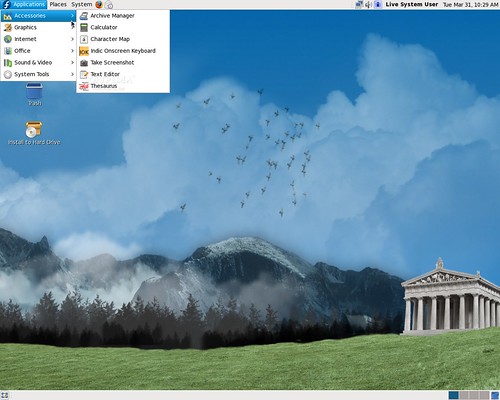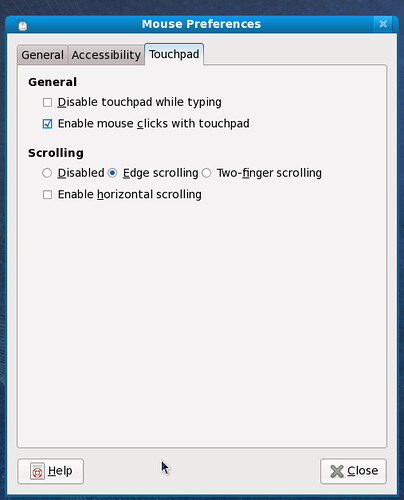Now before I give my first impressions, I must warn that if your a die hard Fedora fanboy, then please STOP reading.
....
Even if your not please note that these impressions are based on the Fedora Live CDs (both standard and kde based) and I have yet to download the DVD release. I did not install the Live CDs but merely ran them Live and only for a short period of time (a little over an hour combined). I tested the Live CDs on both my older Acer TravelMate 4200 laptop as well as the relatively newer Macbook Aluminium Unibody.
F11 on the Acer notebook
The first thing that I noticed was that finally Kernel ModeSetting (KMS) worked on this Intel GMA 950 GPU. If I recalled correctly, with F10, the Intel drivers were broken with KMS. Unfortunately I found the KMS boot splash somewhat boring. Compared to F10, which really showed off the power of KMS with an awesome solar system animation (I saw it on an ATI GPU), F11 had a much simpler Fedora logo that filled up as the system booted. I'm sure there may have been a logical reason for simplifying the animation, but my first impression was it needed more sex appeal.
Once the system had booted and transitioned nicely to the login manager (thanks to KMS), followed by the desktop (after auto login), I found my self further disappointed esthetically, this time due to dull looking wallpaper and theme. IMHO, F11's wallpaper is several steps back when compared to the beautiful wallpapers of F10, F9 or even F8. The desktop theme plays a key part in the first impression and so perhaps they should have stuck to the wallpaper they had during the beta release.

F11 beta wallpaper wasn't so bad
One thing I did like visually over the previous releases was that of the notification popup balloon.

Beyond the look, F11 felt like a very solid distro. Before F10, with earlier releases, I felt somewhat on unstable and shaky ground. F10 changed my perception and F11 takes it a little further.
While pretty much everything worked on my Acer notebook, there were few noteworthy bad first impressions I had with the out of the box experience. First up was the touchpad tapping being turned off by default. Now while I'm aware this is the default behavior on Windows, it is nevertheless a bad idea. Why disable this feature that most find useful? Other desktop focused distros such as Ubuntu or Mint seem to have tap turned on by default. Having said that, its pretty easy to turn tap on using the Gnome mouse preferences dialog. Unfortunately the same cannot be said with KDE 4 Control Center. I was unable to find this setting on the Fedora KDE spin.

Another default setting that I didn't understand was the 3D desktop (aka Compiz) being turned off. Considering Linux very well supports composition on the Intel GPU, I don't understand why Fedora does not want to give this cool first impression feature (actually for me Compiz is beyond cool, its a necessity). The kde spin did not even have the "Turn on desktop effects" helper application and the one that is part of the kde 4 Contol Center was functional but slow.
As far as the applications went, I was thrilled to see Firefox 3.5 beta in there. Even though this was a beta release, most people have reported that it was stable and visibly faster than the previous version. Unfortunately if your on the kde spin, you wont find Firefox at all! I'm also glad to see Pidgin back as the default IM instead of the cool but not so functional Empathy IM, the default on F10. The lack of OpenOffice on the LiveCD struck me as a definite lack, and other Office suites (Gnome Office nor Kde Office) are simply not worthy of being default replacements.
A complaint most often heard from the Windows cross over crowd is the lack of basic codecs for playing multimedia formats. Given the legal nature of shipping these codecs, most desktop distros try to simplify the "finding and installation" process by providing helper software. As far as my tests went, F11 was not friendly in helping me find and install some of the basic codecs such as mp3 or xvid. In contrast Ubuntu seemed to do this reasonably well.
Nevertheless I saw improvements in terms of functionality and stability with Package kit - Fedora's answer to unifying package management in a consistent manner across distros. While its exciting to see where this project is heading, there are still some fundamental usability issues that need to be fixed. For example, a simple thing such as the lack of a proper progress indicator when updating the package database can be frustrating to watch and wait, especially with low speed broadband Internet connections. Another annoyance are the multiple dialog boxes that can appear during an install, in which all of them are waiting for the package database to be released. What would have been better was to have a single dialog which showed the task queue with the current one highlighted and progress indicated.

F11 on the Macbook
Next up was to test how F11 fared with my Linux hating Macbook. As expected I ran into many problems most of which are not unique to F11 but are seen in pretty much all current Linux distros. Two things that did not work with F11 at all but partially worked with Ubuntu/Mint was the touchpad and wireless. On F11 the mouse cursor would not move at all, while on Ubuntu it can be used as a single buttoned mouse (no tap support but click works). The wireless also worked on Ubuntu using the free Broadcom driver with the option to install the proprietary one. Not so in F11 and I had to use the wired connection to fix this. Sound did not work either, but neither did it on other distors. The lack of pommed package in the F11 repo was another frustration in trying to get the touchpad and some multimedia keys working. But this is not to say its impossible and if you google around, you should be able to find a few HOWTOs. I was a bit disappointed that even with the latest Nuova drivers that came with F11, it was still unable to boot via KMS or even auto load the driver under Xorg. Instead F11 seemed to use the vesa driver instead.
Conclusion
Overall I'd recommend F11 for anyone fond of RPM distros, those thinking of upgrading from a previous version or anyone who wants a bleeding edge but rock solid distro with the (almost) latest kernel and set of packages. Personally I prefer deb based ones but with YUM and Package Kit getting better the difference is likely to disappear. I'm definitely going to upgrade (or install from scratch), F11 on the Mac Mini PPC because Fedora supports PPC quite well. If your going the Fedora route, I really couldn't recommend the Kde spin due to the lack of some important pieces and the poor integration. I would rather install the standard Gnome based one and install kde on it.